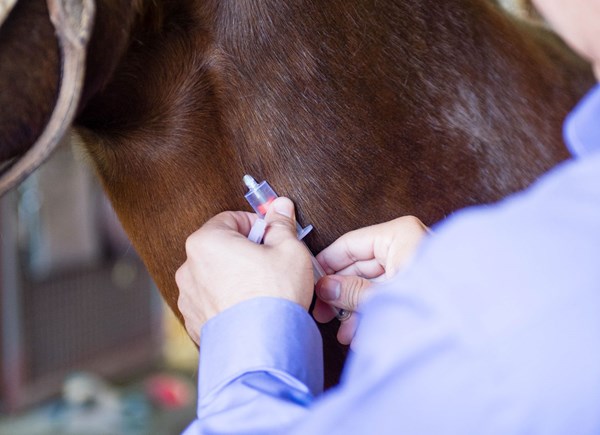Do you ever wonder what the distribution of horse breeds, age and use is currently in the United States as well as the likelihood of owners providing preventive health procedures?
 Credit: Amy Dragoo EIA testing was required for 65.9% of horses in the NAHMs survey before those horses were allowed to commingle with horses already on a property.
Credit: Amy Dragoo EIA testing was required for 65.9% of horses in the NAHMs survey before those horses were allowed to commingle with horses already on a property.The latest (2015) National Animal Health Monitoring System (NAHMS) survey provides comprehensive health information compiled by the USDA Veterinary Services division. Their Animal Health report just came out with facts and figures about the state of the equine industry based on survey results from 28 states representing 72% of nearly 4 million equids in the USA. Here are a few points of interest:
- About 89% of operations have 19 or fewer horses, but account for 58% of horses in the United States.
- The other 11% of operations house more than 20 horses, but account for 42% of U.S. horses.
- Horses age 5-20 years old make up 65.6% of the equine population.
- Horses age 1-5 years old account for 16.5%, with 11.4% of horses being older than 20 years.
- The predominant breed is the Quarter Horse (42.1%), with the greatest numbers living in the West and Central regions. This is in contrast to 7.1% Thoroughbreds, 4.7% Drafts, 3.9% Arabians, and 3.2% Warmblood breeds.
- The Northeast has the highest percentage of draft horses at 15.2%.
Most operations were either farms/ranches (39.5%) or personal residences using horses for show and pleasure (38.8%). Boarding and training operations comprised 9.3% of survey respondents, while breeding farms made up 7.6%. Of notable interest was the use of horses: 47.2% for pleasure, 25% for farm/ranch, 8.5% for breeding, yet only 8.1% for showing and 3.2% for lessons. Racing accounts for 1.6% of horses.
Where do veterinarians fit into the scheme of things?
The majority of those surveyed (nearly 71%) said they had used a veterinarian as their primary information source in the previous year. Not too surprisingly, 65.2% used their farrier as an additional source of information, with 13% using a farrier as their primary source. One-third used other horse owners, veterinary supply and feed store workers, and/or horse care magazines or books as their information sources.
Riding instructors, acupuncturists, non-veterinarian dentists and the Internet were other common sources of information for making health decisions.
Nearly 79% of operations had a veterinarian provide a service at least once in the previous year. Facilities designated as boarding, training or riding stables, or breeding farms, were more likely to use veterinary services than farm/ranch operations. More veterinary services were used in the Northeast (about 57%) than in the Western U.S. (38%).
Vaccinations were given on 66.7% of equine premises surveyed, with 52% of these performed by veterinarians and 44% administered by owners. However 78.5% of boarding/training stables used veterinarians for vaccine administration. The larger the size of the operation, the more likely that vaccinations were given.
Fecal testing for intestinal parasites was performed on 17.5% of operations, although 38.4% of operations housing 20 or more horses did fecal testing for parasites.
Overall, 39% of operations used a veterinarian as the primary person taking care of dental needs, whereas 17% used a non-vet equine dental provider. In general, 40% of operations did not provide any dental care.
For hoof trimming services, professional farriers were used at 60% of operations, 25% had employees to do the work, and 7% did not offer any foot care.
Nearly 37% of horses were tested for EIA in the previous 12 months. The incidence of EIA in the USA in 1972 was 4%. However, through EIA testing this incidence had been reduced to 0.005% by 2015.
Biosecurity measures were examined for introduction of new or incoming horses on a premise:
- EIA testing was required for 65.9%
- Vaccination within the past year was required for 58.7%
- Deworming within the past year was required for 58.9%
- Official certificate of veterinary inspection (CVI) was required for 46.8%
- Quarantine was required in 44% before allowing contact with resident horses.
Only 8.6% of operations use computerized records, with 20% using a health logbook, 21% handwritten notes on a calendar or in a checkbook, and 19.3% using records maintained by a veterinarian. The largest number (31%) had no health records kept on the horses.
The Take-Home Message
Clearly there are areas of preventive health care that can be improved and offered to more horses throughout the country. Veterinarians have an important role in client education to encourage these objectives, particularly in the realms of immunizations, parasite control testing, dentistry and biosecurity.








